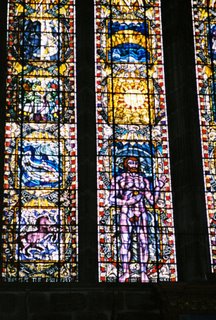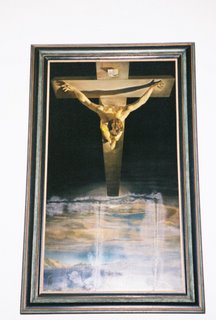No Buds
There was no reason to scrape my body out of bed for breakfast, so Ron went and I showered while he was gone. The shower is electrical and needs to be turned on with a switch before the water comes out. There is a plastic box on the wall with which to regulate the water flow from drip to drizzle and a lever to adjust the temperature of the water. You have two choices: frozen or scalding, with the intermediate being alternating cryogenic or boil your skin off depending on the moment. There is a brief few seconds in between where the temperature is bearable, so you do a strange type of shuffle or dance getting scrubbed. It is similar to the dance the Hokey-Pokey. You put your left foot in, you take your left foot out, you put your right foot in and shake it all about. The shaking part is only because you missed your window of opportunity and you have now either burned yourself and need to cool off or your froze yourself and you are trying to gain your circulation back. Brian informed us that Michael called at 2:00 am and woke him out of a sound sleep. We were to call him back again on his cell phone.
After my aquatic aerobics were out of the way, we walked to the bus to the city center. There is not as much urgency to get to the city center in  The leaves are starting to turn colors, but it seems that the most colorful are already on the ground and those on the trees are still green.
The leaves are starting to turn colors, but it seems that the most colorful are already on the ground and those on the trees are still green.
Once we took the bus to the city center, after completing one route, we went around one the other route one more time until we reached St. Mungo’s Cathedral. This is a Church of Scotland property, but the story goes that a young man named Kentigern studied with St. Ninian and later St. Serf. He later came to what is now
The cathedral has above the front doors, the most splendid stained glass that I have ever seen. It was bright and light with colors that made it come alive. The scene was of Adam and Eve. The main church area or nave is now devoted to church visitors and other historical events. On the left side of this room, there are three panels of stained glass that are done in various shades of blue. These are the millennium windows and were unveiled on June 3, 1999. The technique used was the same used in the 15th century to maintain the integrity of the existing windows. It is a combination of multiple layer etching, painting, and silverstaining. Within the glass there are the words from scriptures of the New Testament and symbols that are associated with the text. The text is done in a helter-skelter fashion, which gives it fluidity and draws the eye to investigate further. We were in awe of the beauty of the monochrome widows and fortunately, the sun was shining outside to illuminate them to their full potential. Toward the back of this very large room, is a nave and after climbing about ten steps, there is another full and complete church beyond this. The stained glass in the back wall and above the altar is also quite beautiful.
In the basement is yet another church and it is said that the bones of St. Mungo are buried there. In the back of the downstairs church there are also three small chapels dedicated to different saints.
The building in the front of the church is the  The way the light shines on Christ’s shoulders is a magnificent piece of artistic talent, but the whole painting is a marvel that held my attention for a good length of time. A Spanish Carmelite friar who in the 1500’s had a vision and sketched it inspired the painting. They allow pictures to be taken and Ron and I both left our cameras at the house, so this is a must do again. The rest of the second floor of this museum is filled with elements of all world religions from birth to death and all stages in between. They not only cover the traditional religions that would normally come to mind, but also tribal ones from
The way the light shines on Christ’s shoulders is a magnificent piece of artistic talent, but the whole painting is a marvel that held my attention for a good length of time. A Spanish Carmelite friar who in the 1500’s had a vision and sketched it inspired the painting. They allow pictures to be taken and Ron and I both left our cameras at the house, so this is a must do again. The rest of the second floor of this museum is filled with elements of all world religions from birth to death and all stages in between. They not only cover the traditional religions that would normally come to mind, but also tribal ones from
The third floor was a full expedition on the B’ahai religion from its founding to today’s impact on
We walked back toward the center and found a series of tea or coffee cafés near the Royal Museum of Modern Art. Sitting outside watching the people and sipping tea, Ron had a snack. He bought enough for two, but after a few bites, I lost my appetite since food has no appeal without taste. Eating is now just another exercise and I despise exercising. The tea might as well have been water for all that I could taste. I did need to use a bathroom, but the café told me I would need to use the one in the museum across the street. Leaving Ron at the café to finish off my snack, I took off across the street. Modern art is not my favorite, but as I entered the museum for one very different reason that had nothing to do with art appreciation, the works of art caught my attention. This was a place to bring Ron back to after his tea break.
Some of the pieces were typical splashes of paint on canvas, but most were truly incredible works of imagination. As you enter the lobby there is a fiberglass statue…never mind that one, we’ll go on. Inside there are two statues on either side of the door. One was called The Fox and the other The Raven Man. Both were about five feet high and sculpted in bronze. One of my favorites was a painting that was done is framed ‘broken’ pieces. The painting was a composite of the artist’s mother’s apartment. She had called him to say she had an accident and after he went running over there, it turns out she broke a teacup and saucer. Another painting on wood that was very impressive was of an apartment complex. When you moved, the painting moved. It was a brilliant work of optical illusion. The building itself was a work of art and not modern at all. It embraced the best of Greco-Roman architecture.
Our next venture was to the
In the
On the way back to the city center, we came across Tennent’s pub that offered meal specials before 5:00 pm: two meals for five pounds. Since, I cannot taste, I did not see any sense in spending too much money on food, and so we stopped in for an early dinner. There were seven choices for the special. Ron ordered fish and chips and I chose sausage, mashed potatoes, and onion gravy. After five bites, I was full and discouraged, as it looked so delectable. Ron ate his and then part of mine. The pub has twenty beers on tap and 40 cask ales. Under normal conditions, we would have stayed for a taste testing, but even though I ordered a half pint of their strongest flavorful beer, it was like drinking marsh water and a waste of good hops.
It was meant to be an early evening, but it never seems to work out that way. Ron wanted to stop by the downtown mall and see if the stores were open. We had to shop for a prize for our contest winner. It was now after 7:00 pm and the stores close at 6:00 pm. All of the little stores were already closed also.
One more stop before we get the bus for home, check the performance time for the Sharmanka show. This is the group that created the millennium clock I wrote about in the















0 comments:
Post a Comment